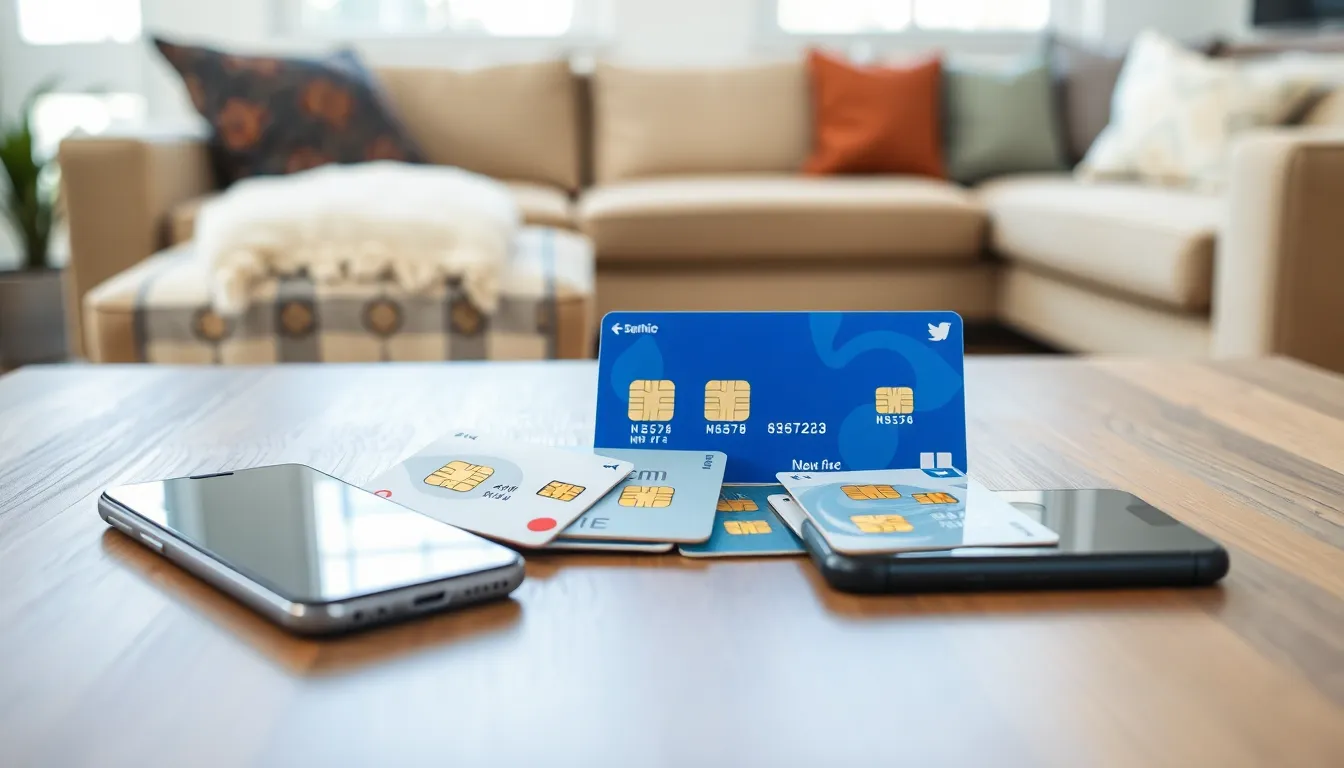In a world where connectivity reigns supreme, the quest for a new SIM card for an iPhone can feel like searching for buried treasure. Whether it’s for a shiny new device or simply to revive an old one, knowing the cost can save some serious headaches—and a few bucks.
Table of Contents
ToggleUnderstanding SIM Cards for iPhones
Understanding SIM cards is essential for managing an iPhone. It’s important to know their function and types before purchasing or replacing one.
What is a SIM Card?
A SIM card, or Subscriber Identity Module, connects an iPhone to a mobile network. It stores crucial information, including phone numbers, contacts, and user account details. Each SIM card contains a unique identifier that allows the device to authenticate with the carrier. When users switch devices or carriers, they often transfer their SIM card for continuity. In summary, a SIM card is vital for enabling cellular service and personalizing the user experience.
Types of SIM Cards for iPhones
iPhones generally use two types of SIM cards: Nano-SIM and eSIM. Nano-SIM is the physical card that fits in most newer iPhones. It measures 12.3mm by 8.8mm, making it the smallest SIM format in use. eSIM, on the other hand, is embedded within the device, activating through a digital process. This technology allows users to switch carriers without changing their physical card. Certain iPhone models support dual SIM functionality, enabling the use of both the Nano-SIM and eSIM simultaneously, offering flexibility for personal and business usage.
Pricing for New SIM Cards

New SIM card prices vary widely based on location and mobile carriers. Understanding average costs helps in budgeting for mobile needs.
Average Cost in Different Regions
Average costs differ across regions. In the United States, new SIM cards typically range from $5 to $30, depending on the provider. Some carriers offer free SIM cards with a service plan. In Europe, prices often range from €10 to €25, influenced by local carriers and packages. Asia presents a similar landscape, with SIM cards priced between ¥1,000 and ¥3,000 in Japan and ₹100 to ₹500 in India. Variances in deals offered by suppliers affect these averages.
Factors Influencing SIM Card Prices
Several factors impact SIM card pricing. Carrier competition often leads to more aggressive pricing strategies. Promotions and bundled services can lower initial costs. Location also plays a crucial role, as urban areas tend to have more competitive pricing compared to rural locations. Type of SIM card, whether a physical Nano-SIM or an eSIM, influences costs as well. Finally, additional features such as data plans and international calling capabilities can significantly alter prices. Understanding these factors can guide consumers in making informed choices.
Where to Buy a New SIM Card
Obtaining a new SIM card for an iPhone involves several convenient options. Consumers can choose from carrier stores, online retailers, and various local outlets.
Carrier Stores
Carrier stores offer a reliable source for purchasing a new SIM card. Major providers like Verizon, AT&T, T-Mobile, and Sprint have physical locations across the United States. In these stores, customers can receive personalized assistance from staff. Prices for SIM cards typically range from $5 to $30. Activation often occurs in-store, streamlining the initial setup process. Additionally, sales representatives can provide guidance on selecting the best plan based on individual usage needs. Visiting a carrier store ensures that customers gain instant access to customer service and support.
Online Retailers
Online retailers present a convenient option for acquiring SIM cards. Websites like Amazon and Best Buy provide a wide selection of SIM cards from various carriers. Often, these retailers feature competitive pricing and customer reviews, which can aid decision-making. Prices may vary from $5 to $30, depending on the carrier and plan. Ordering online facilitates delivery right to one’s doorstep, eliminating the need for in-person visits. Many online platforms also offer instant activation codes and comprehensive guides to simplify setup. By selecting an online retailer, consumers enjoy convenience and a diverse shopping experience.
Activation Fees and Additional Costs
Understanding activation fees and additional costs for a new SIM card is crucial for iPhone users. Fees vary based on carrier plans and purchasing methods.
Carrier Activation Fees
Carrier activation fees typically range from $10 to $50, depending on the service provider. Each carrier, including Verizon, AT&T, T-Mobile, and Sprint, sets its own rates. Some carriers may waive this fee during promotions or when signing up for specific plans. Additional costs can arise from services such as phone number porting or international services. Customers should inquire about these fees at the time of purchase to avoid surprises.
Prepaid vs. Postpaid Options
Prepaid SIM cards generally have lower upfront costs, often including activation fees in the card price. Some prepaid plans offer no contract, allowing users flexibility in managing their expenses. Postpaid options usually entail higher activation fees, reflecting the commitment to a monthly plan with specific terms. Monthly billing includes additional charges for data, texts, and calls. Users should assess their usage habits when choosing between prepaid and postpaid to ensure optimal cost efficiency.
Navigating the process of obtaining a new SIM card for an iPhone can be straightforward with the right knowledge. By understanding the costs and options available consumers can make informed decisions that suit their needs. Whether opting for a physical Nano-SIM or the more modern eSIM technology the choice should align with individual preferences and usage patterns.
It’s essential to consider factors like activation fees and potential promotions from carriers that could impact overall expenses. With various purchasing avenues available including carrier stores and online retailers users have the flexibility to find the best deal. Ultimately being well-informed empowers users to maximize their iPhone experience while keeping costs manageable.








